Why you can trust Tom's Hardware
AMD Ryzen 5 5600 and 5500 Power Consumption and Efficiency
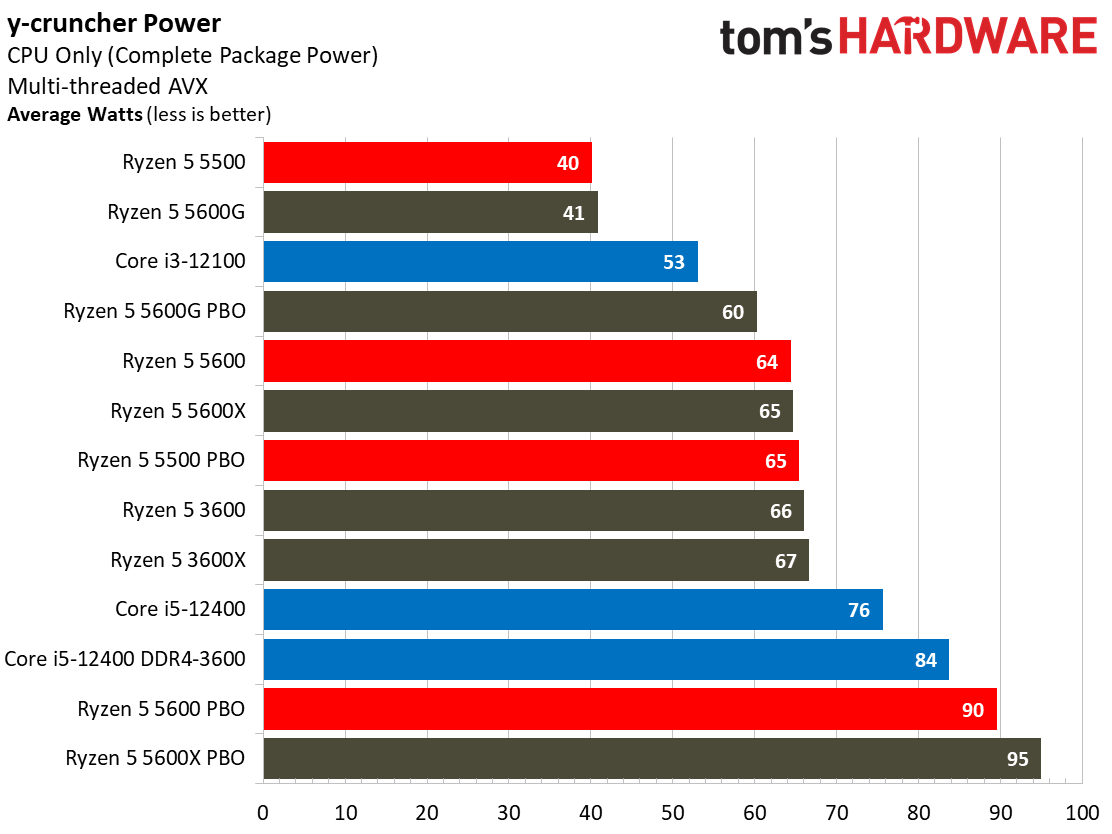
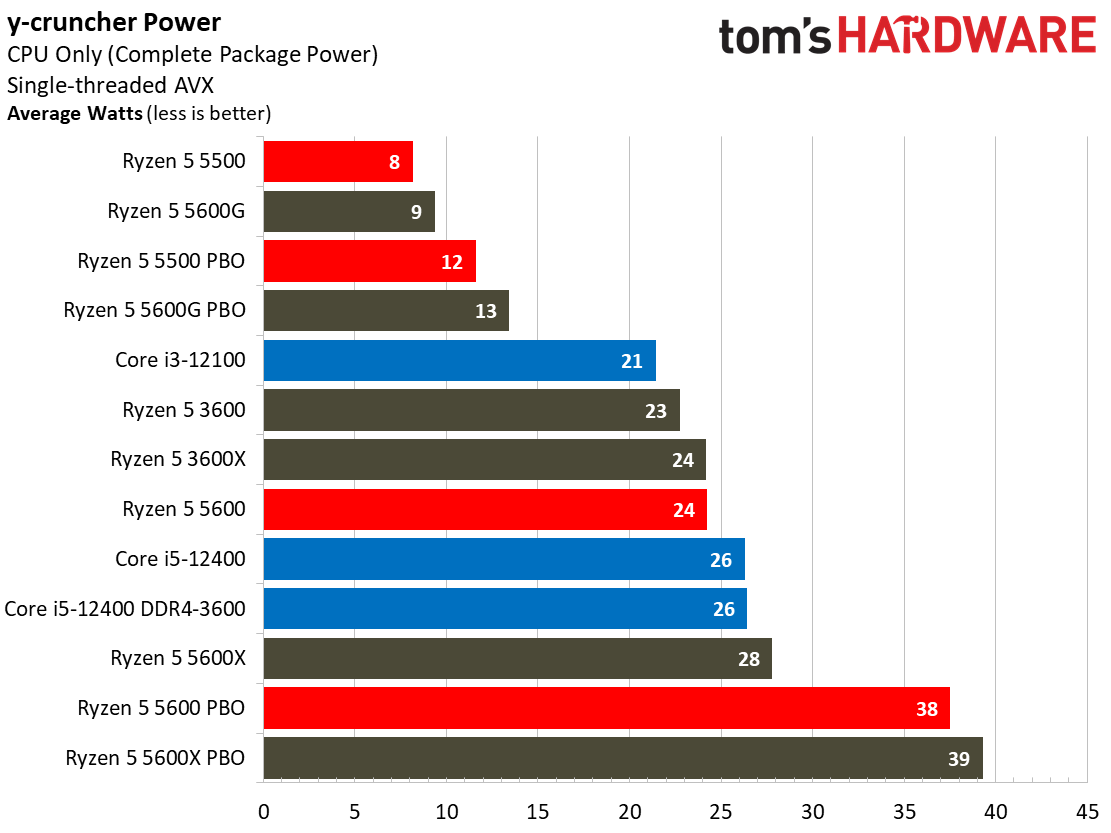
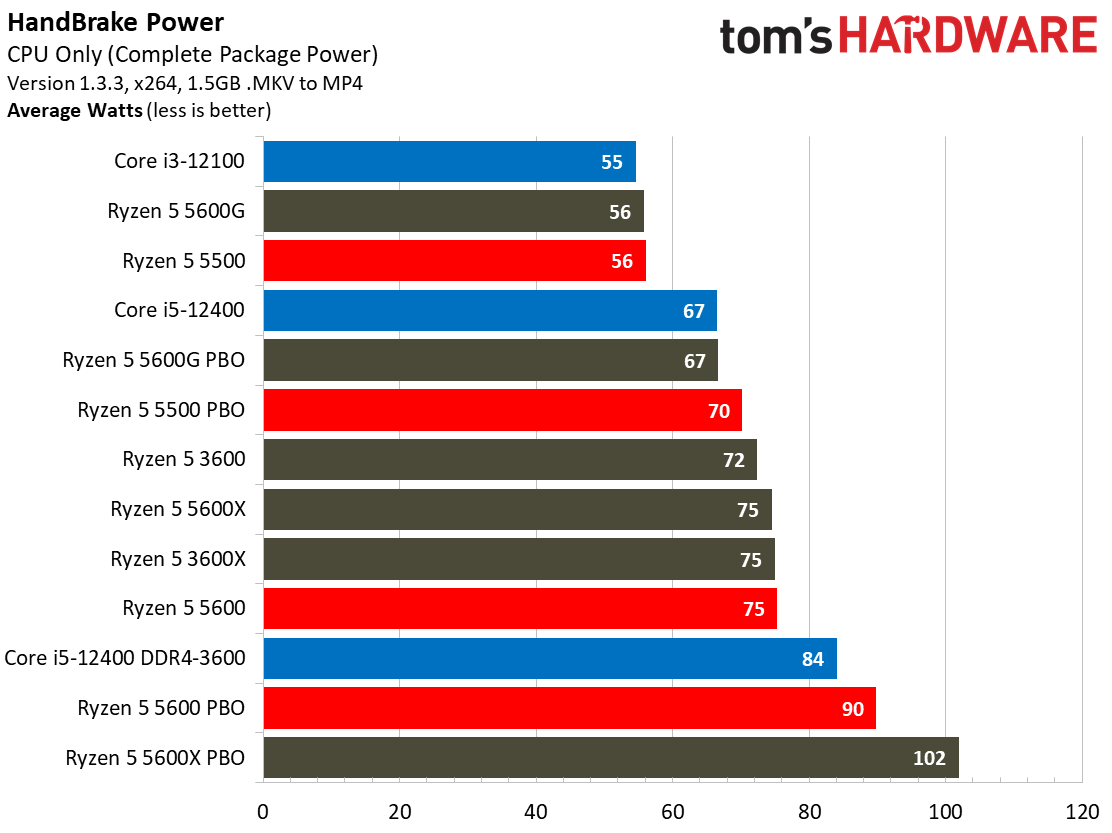
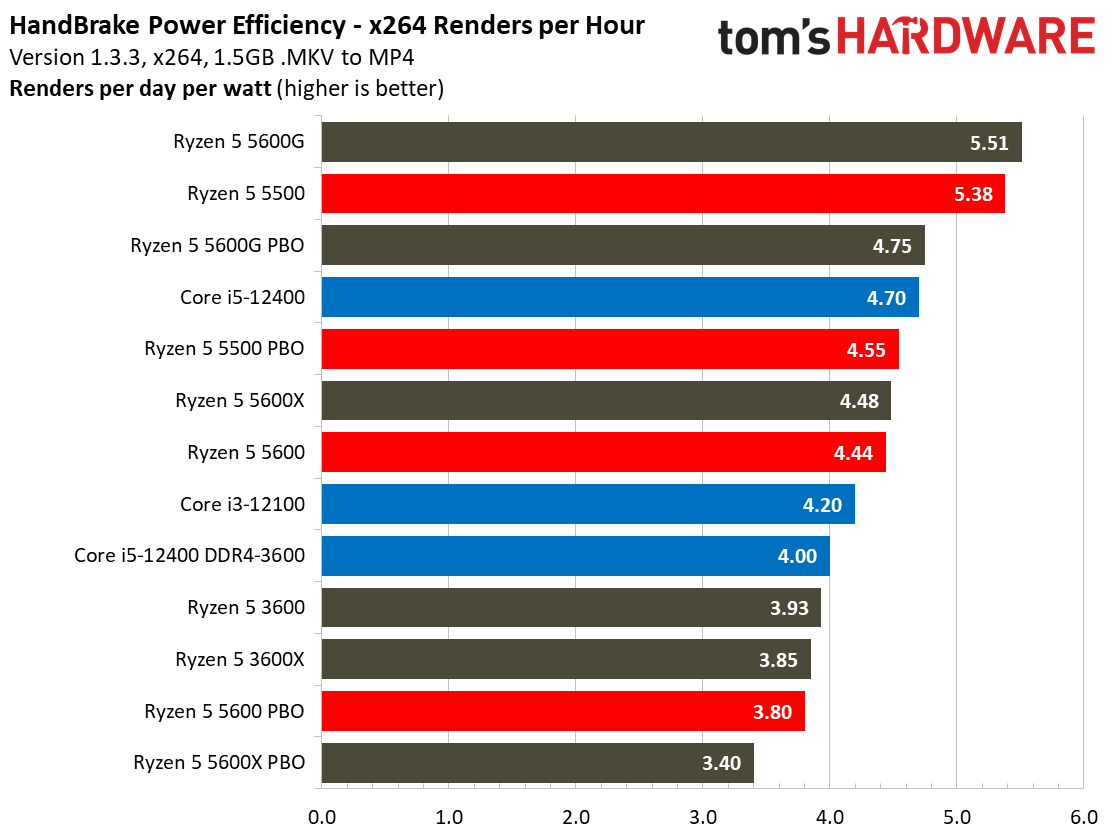
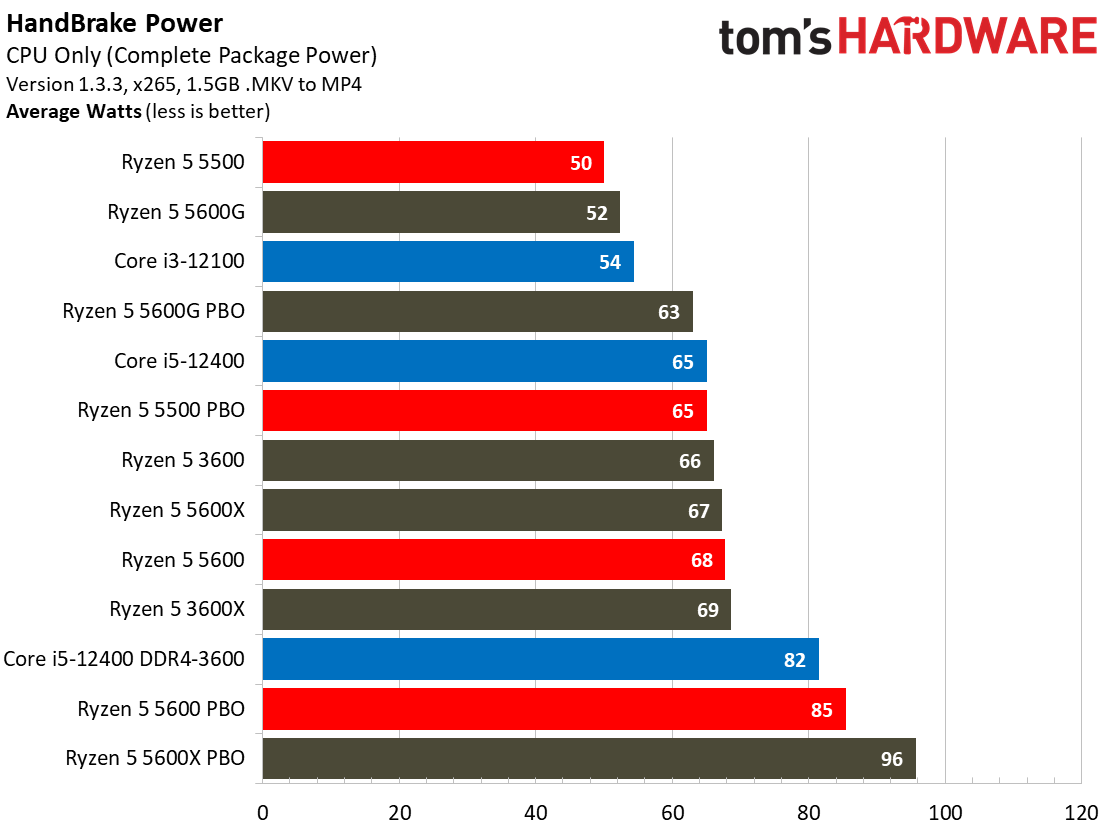
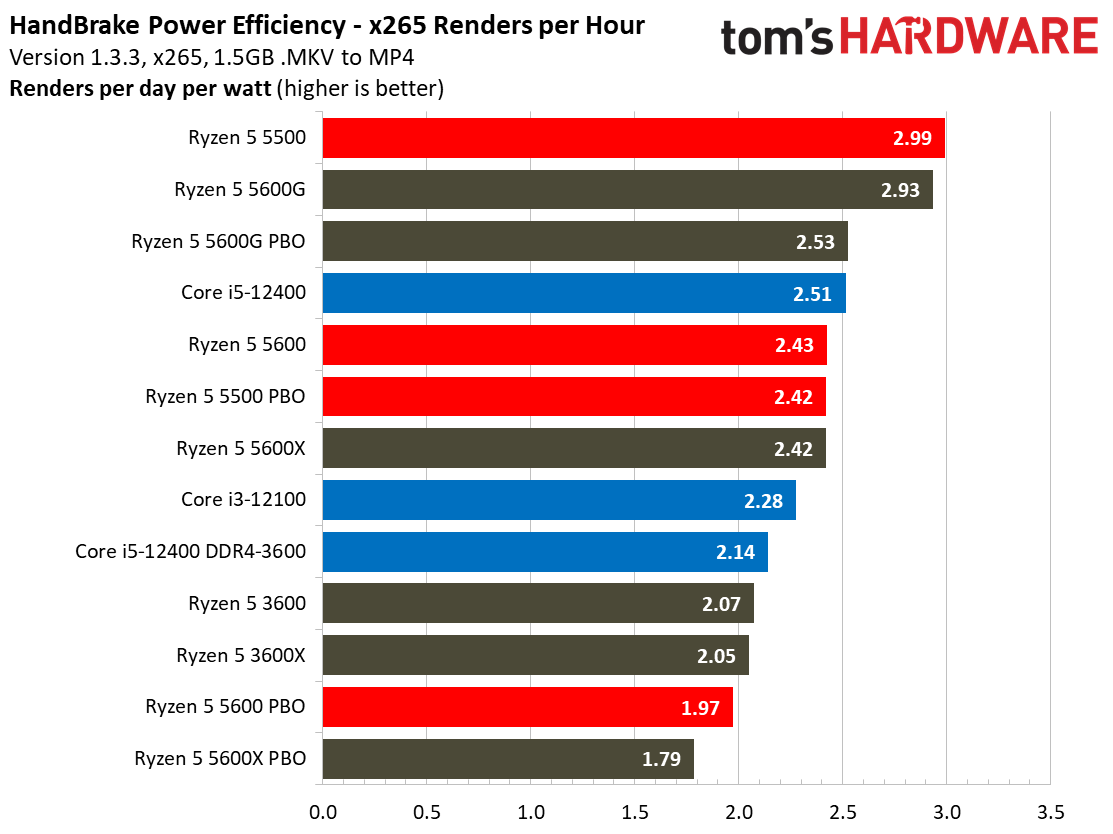
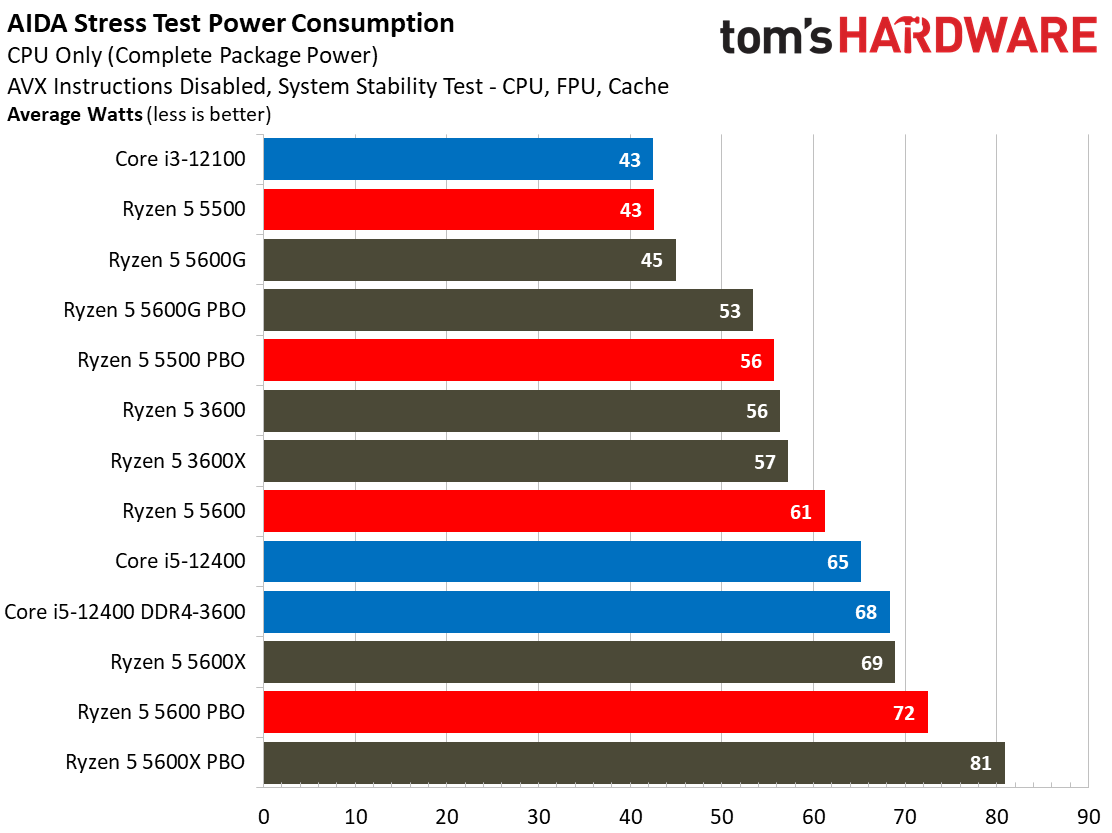
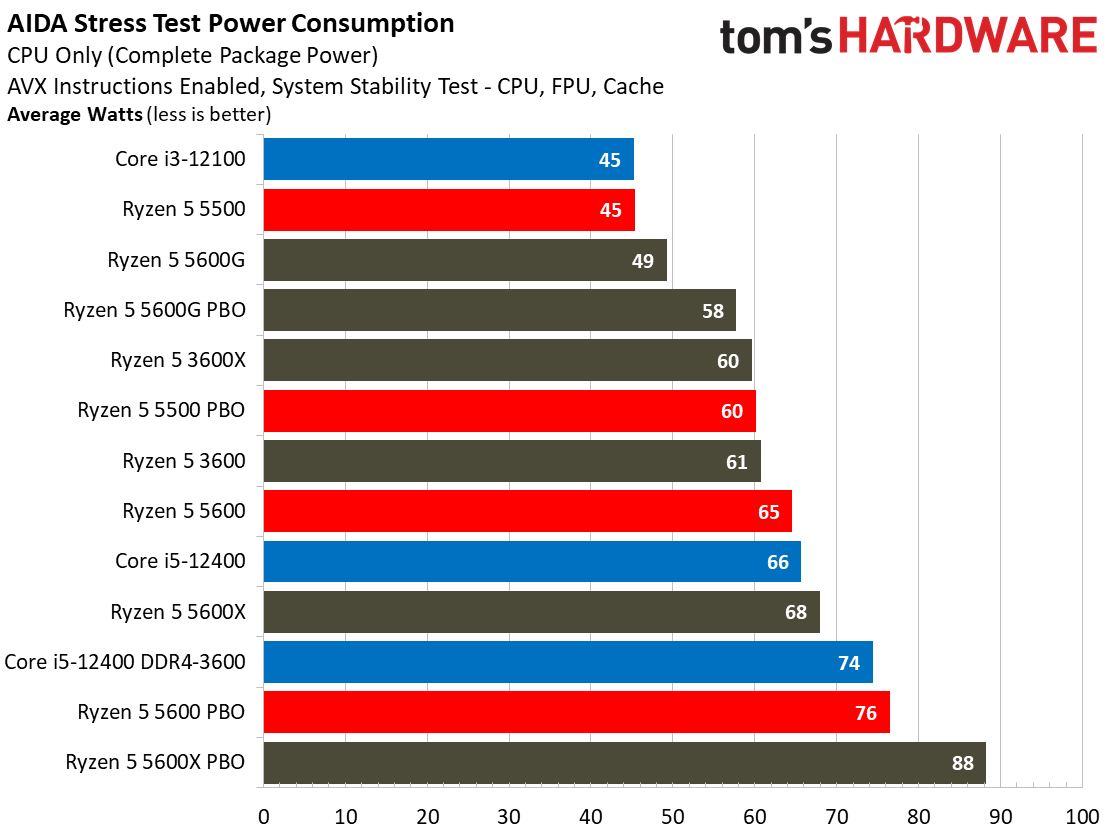
The Intel Alder Lake chips still suck more power than AMD's Zen 3-powered Ryzen 5000 series chips, but pairing the Intel 7 process with the hybrid architecture brings big improvements, particularly in threaded work.
The Zen 3-equipped Ryzen 5 5600G has long been the most efficient chip we've tested, but the Ryzen 5 5500 gives it a run for the money in the HandBrake renders-per-day-per-watt measurements. That isn't entirely surprising, as the 5500 is merely a lower-clocked version of the 5600G, and efficiency tends to improve the further you move to the left on the voltage/frequency curve.
The Ryzen 5 5600 is also plenty efficient, but the Core i5-12400 takes a slight lead in the efficiency metrics. As you'd expect, the Core i5-12400 and Core i3-12100 draw more power during the heavily-threaded AVX y-cruncher workload.
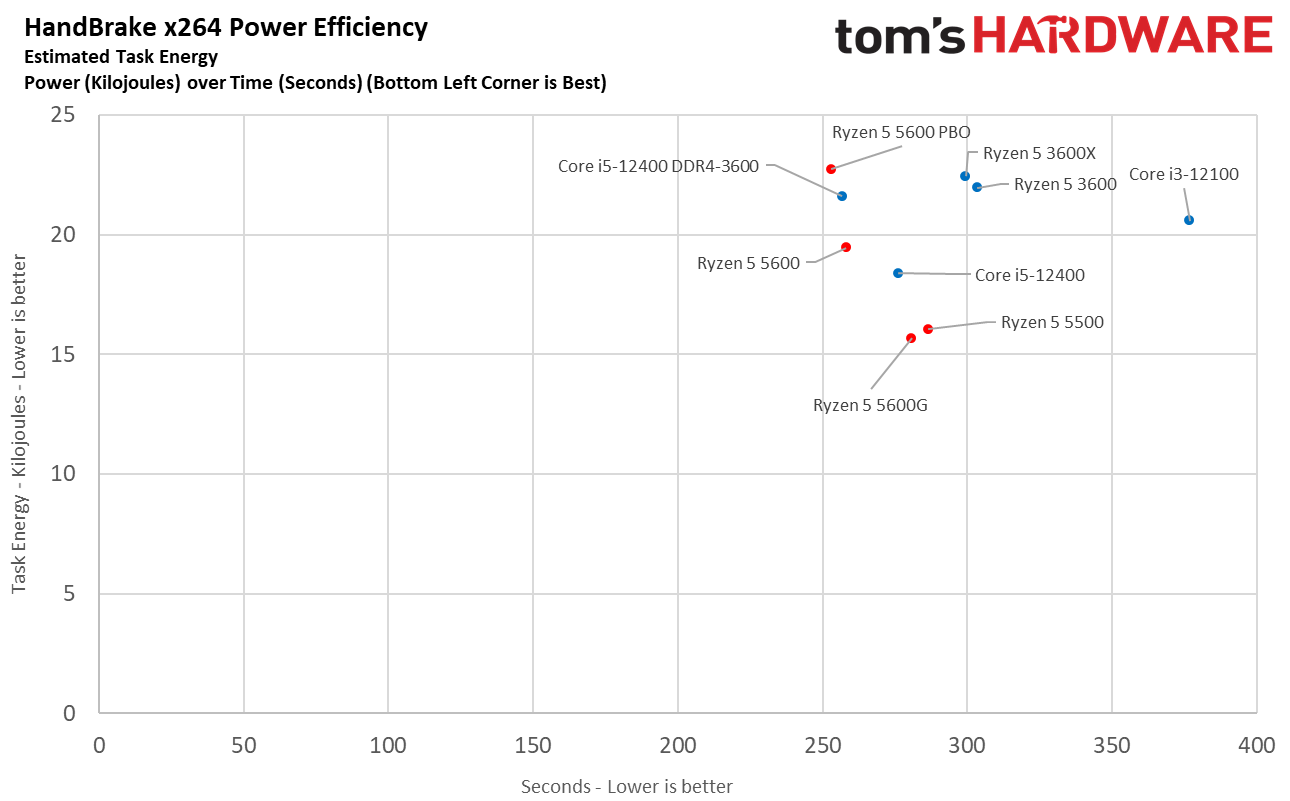
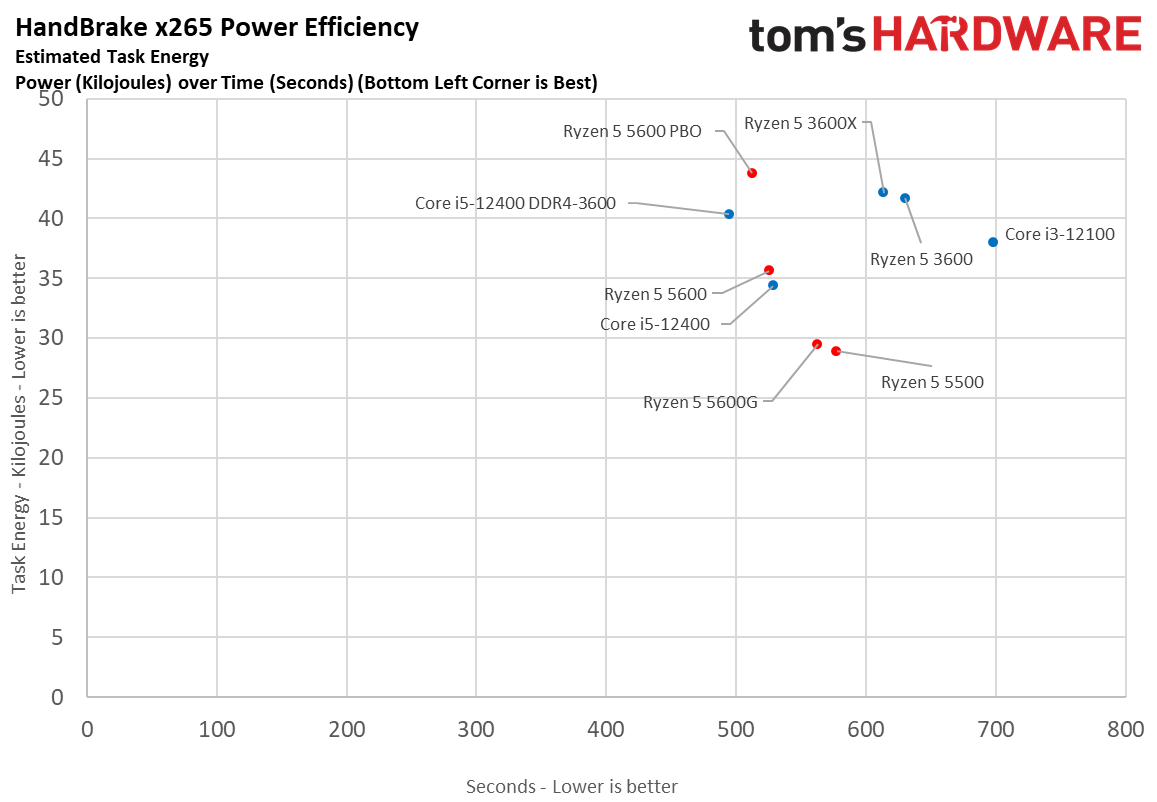
Here we take a slightly different look at power consumption by calculating the cumulative energy required to perform Blender and x264 and x265 HandBrake workloads, respectively. We plot this 'task energy' value in Kilojoules on the left side of the chart.
These workloads are comprised of a fixed amount of work, so we can plot the task energy against the time required to finish the job (bottom axis), thus generating a really useful power chart.
Bear in mind that faster compute times, and lower task energy requirements, are ideal. That means processors that fall the closest to the bottom left corner of the chart are best.
AMD Ryzen 5 5600 and 5500 Test Setup
We tested with Windows 11 on an X570 motherboard to maintain a comparable test environment with the rest of the processors in the test pool. Of course, you wouldn't pair this chip with this class of motherboard, but even lower-end 300-series motherboards should provide enough juice for full operation. We also tested with secure boot, virtualization support, and fTPM/PTT active to reflect a properly configured Windows 11 install. We have a full breakdown of the test system configurations at the end of the article.
Our overclocks were rather straightforward — we enabled the auto-overclocking Precision Boost Overdrive (PBO) feature with 'advanced motherboard' settings and adjusted the scalar setting to 10X. You can see details of how to do this in our How to Overclock a CPU feature. Additionally, as outlined in the table below, we made sure to match our memory overclocks with a 1:1 FCLK/memory clock ratio to keep latency low, which games love. For the Ryzen 5 5500, we had to increase the SoC voltage to 1.25V to solidify our DDR4-4000 memory overclock, but that wasn't required for the Ryzen 5 5600, largely because it tapped out at a lower DDR4-3800 in 1:1 mode. We tested the Ryzen 5 5600 and Ryzen 5 5500 in two different configurations each:
- Ryzen 5 5600: Corsair H115i 280mm water cooler, PBO Disabled, DDR4-3200
- Ryzen 5 5600 PBO: Corsair H115i 280mm water cooler, PBO Enabled, Scalar 10X, DDR4-3800, FCLK 1900 MHz (1:1 Ratio)
- Ryzen 5 5500: Corsair H115i 280mm water cooler, PBO Disabled, DDR4-3200
- Ryzen 5 5500 PBO: Corsair H115i 280mm water cooler, PBO Enabled, Scalar 10X, DDR4-4000, FCLK 2000 MHz (1:1 Ratio)
| Intel Socket 1700 DDR4 (Z690) | Core i3-12100, Core i5-12400 |
| Row 1 - Cell 0 | MSI Z690A WiFi DDR4 |
| Row 2 - Cell 0 | 2x 8GB Trident Z Royal DDR4-3600 - Stock: DDR4-3200 14-14-14-36 / OC: DDR4-3800 |
| AMD Socket AM4 (X570) | Ryzen 5 5600X, 5600G, 5600, 5500, 3600X, 3600 |
| MSI MEG X570 Godlike | |
| Row 5 - Cell 0 | 2x 8GB Trident Z Royal DDR4-3600 - Stock: DDR4-3200 14-14-14-36 | OC/PBO: DDR4-3800 (5600X, 5600), DDR-4000 (5500), DDR4-4400 (5600G),Second-gen DDR4-3600 |
| All Systems | Gigabyte GeForce RTX 3090 Eagle - Gaming and ProViz applications |
| Row 7 - Cell 0 | Nvidia GeForce RTX 2080 Ti FE - Application tests |
| 2TB Sabrent Rocket 4 Plus | |
| Silverstone ST1100-TI | |
| Row 10 - Cell 0 | Open Benchtable |
| Row 11 - Cell 0 | Arctic MX-4 TIM |
| Row 12 - Cell 0 | Windows 11 Pro |
| Cooling | Corsair H115i, Custom loop |
| Overclocking note | All configurations with overclocked memory also have tuned core frequencies and/or lifted power limits. |
- MORE: AMD vs Intel
- MORE: Zen 4 Ryzen 7000 All We Know
- MORE: How to Overclock a CPU
- MORE: How to check CPU Temperature
Get Tom's Hardware's best news and in-depth reviews, straight to your inbox.
Current page: AMD Ryzen 5 5600 and 5500 Power Consumption, Efficiency and Test Setup
Prev Page The Non-X Factor Next Page AMD Ryzen 5 5600 and 5500 Gaming Benchmarks
Paul Alcorn is the Editor-in-Chief for Tom's Hardware US. He also writes news and reviews on CPUs, storage, and enterprise hardware.
-
ohio_buckeye I see why they did it though. They must have known the 5600 would be like the 3600. 95% of the performance of the x model and they must not have sold a lot of the x models in the zen 2 days, but maybe they figure by offering the 5600x first they’d make money from people who wanted to update and knew people wouldn’t buy as many of the upper models if the lower ones were available.Reply -
escksu 5600 could have been that killer chip. But it's too late now. I originally wanted to upgrade my 3600 but was put off by 5600x's price. Now, I don't see any reason to go for 5600 since AMD will be releasing new cpus very soon. Even Intel too.. so rather skip the 5000 series.Reply -
King_V The too-little too-late argument falls a little flat. I mean, that reasoning does make sense if you're only thinking along the lines of building a new system from scratch, but for upgrading an existing one, it can make sense.Reply
Not everyone with a Zen or Zen+ chip jumped to Zen 2.
EDIT: don't get me wrong, AMD should've come up with the BIOS updates sooner, and these chips could've done with being released a little earlier, but it seems a lot of people fall into the trap of looking at it only from a "build an entirely new AMD system vs build an entirely new Intel system" . . . and also aren't paying attention to the price drops. -
King_V Reply
Um, what's your point? Did you take a look and compare Intel's December 2021 stock price to June 2022?Tom Sunday said:Firing Back at Alder Lake! I am very disappointed with AMD continuing the bringing back trick, reengineering products, proffering rearchitected RDNA marketing efforts and generally offering lower-cost and lower-performing version models. Another example was AMD’s last minute effort and ditch with throwing the 5800X3D into the market representing the company's last hurrah for its long-lived Socket AM4 platforms.
But for me all of this 'rehash business' is really all about my money in the bank! A tainted AMD? The company’s share price has dropped significantly since December 2021 selling at $161 per share to whereby today June 27, 2022 it’s down to $88. Is there still hope for investors and a dream of a repeat in AMD stock pricing doubling again as was seen in 2020. Headwinds: AMD’s GPU and CPU’s have continued in struggling hard to remain competitive with NVIDA and INTEL! Besides astute investors would like to see AMD in building their own ‘Mega Fabs’ preferably here in the U.S and not relying on foreign entities in controlling AMD’s future and ultimate survival! Most certainly I would like to see AMD’s own production facilities rather then their seemingly continued 'refresh dancing' in the past. -
tennis2 As mentioned in the article, they might just be using these to clear stock of IGP-less APUs. Assumedly stock would be limited, so it makes sense to wait until now to launch them. By Sept/Oct nobody would buy these anyway, but until then they can clear the warehouse shelves and they don't have to purposefully disable functioning IGPs to create these SKUs for an extended retail period.Reply -
King_V ReplyTom Sunday said:This said I really would like AMD to doubling their stock value again. This alone would most certainly renew and or refurbish my fan status for the immediate future.
I see. Your only concern appears to be whether AMD's stock value will double again. I think you might've joined the wrong forum, then. This is a PC/tech enthusiast site, not an investment site. -
Atom Symbol ReplyAdmin said:We review AMD's new Ryzen 5 5600 and Ryzen 5 5500 that bring budget chips to the company's vaunted Zen 3 lineup.
AMD Ryzen 5 5600 and 5500 Review: Firing Back at Alder Lake : Read more
In year 2022, a review of an 6-core CPU, with some 4-core CPUs in the charts - but without any 8-core CPUs in the charts, is a pointless review. -
TerryLaze Reply
Even in the year 2022 not everybody needs more than 4 cores, for gaming even the lowest CPU in this chart is above 100FPS avg and 80FPS 99th.Atom Symbol said:In year 2022, a review of an 6-core CPU, with some 4-core CPUs in the charts - but without any 8-core CPUs in the charts, is a pointless review. -
Beelzeboss Replyescksu said:5600 could have been that killer chip. But it's too late now. I originally wanted to upgrade my 3600 but was put off by 5600x's price. Now, I don't see any reason to go for 5600 since AMD will be releasing new cpus very soon. Even Intel too.. so rather skip the 5000 series.
I see a reason. Its a 20-30% performance increase for current and future GPU without the need to upgrade my entire system. I have no intention of replacing my B550 mobo and 32GB 3600 to upgrade CPU next gen.